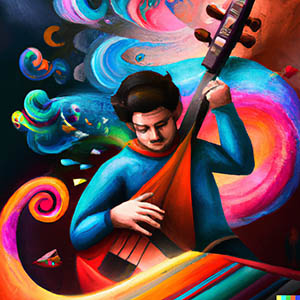Synesthesia in Music
Synesthesia is a condition in which stimulation of one sensory pathway triggers the involuntary stimulation of another pathway. For example, a person with sound-color synesthesia may see colors associated with specific sounds or music. This phenomenon has been studied extensively in the context of music, where it can provide a unique and immersive experience for both synesthetes and non-synesthetes alike. In this article, we'll explore the fascinating world of synesthesia in music.
What is Synesthesia in Music?
Synesthesia in music is a type of synesthesia in which the perception of sound or music is linked with the perception of color or other sensory experiences. For example, a synesthete may perceive a specific note or chord as a certain color, or they may see patterns or shapes in response to different types of music.
Studies have found that synesthesia in music is more common than other types of synesthesia, with an estimated 1 in 1,000 people experiencing some form of sound-color synesthesia. It is also more common among musicians, with some studies suggesting that up to 20% of professional musicians may experience synesthesia.
How Does Synesthesia in Music Work?
The exact mechanisms behind synesthesia in music are still not fully understood, but research suggests that it may be related to increased connectivity between different areas of the brain responsible for processing sensory information. In particular, studies have found that synesthesia in music is associated with increased activity in brain regions involved in visual processing, such as the visual cortex.
It is also believed that synesthesia in music may be influenced by emotional and cultural factors. For example, a study published in the Journal of Experimental Psychology found that synesthetic associations between colors and music were influenced by the emotional content of the music, with sad music more likely to be associated with dark colors and happy music more likely to be associated with bright colors.

Applications of Synesthesia in Music
Synesthesia in music has a number of interesting applications, both in the realm of music itself and in other areas of life. For example, some musicians may use their synesthetic experiences to enhance their musical performances, using visual imagery to guide their playing or composing. Similarly, some composers may use synesthesia as a source of inspiration, creating music that is specifically designed to evoke certain colors or other sensory experiences.
Synesthesia in music may also have applications in the field of music therapy, where it can be used to create personalized soundscapes for individuals with specific sensory needs. For example, a person with synesthesia may be able to use music as a way of controlling their sensory experiences, creating a calming or stimulating environment as needed.
Finally, synesthesia in music has the potential to enhance our understanding of the brain and how it processes sensory information. By studying synesthesia in music, researchers may be able to gain new insights into the underlying mechanisms of sensory processing and perception.
In conclusion, synesthesia in music is a fascinating phenomenon that has captured the attention of scientists, musicians, and music enthusiasts alike. By linking the perception of sound and music with other sensory experiences, synesthesia in music provides a unique and immersive way of experiencing music that is both creative and innovative.
While much is still unknown about the precise mechanisms behind synesthesia in music, ongoing research is shedding new light on this fascinating topic. As our understanding of synesthesia in music continues to grow, it is likely that we will discover new applications and insights into the nature of sensory perception and the human brain.